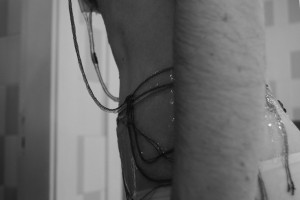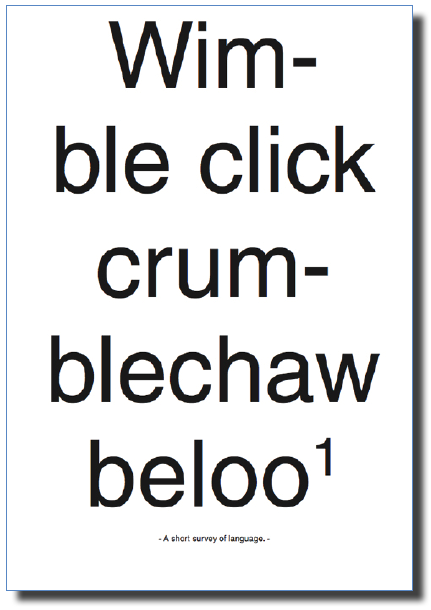In the Boijmans Van Beuningen currently is an Exhibition called: The Future of Fashion is Now. One of the participates is Lara Torres.
Her work ‘an impossible wardrobe for the invisible’ takes part in the ‘New Values and New Stories’ part of the Exhibition.
About the part ‘New Values and New Stories’ the autor, Jose Teunissen, writes in the book of the exhibition: “Today’s designers are trying to recline and recalibrate the fashion system in a number of ways. The designers of the new generation are quick to criticise the fashion system, the compulsion to engage in overconsumption, and concepts such as brand identity a local identity, but they are also importing fashion with a new set of values. One important example is the ‘Slow Fashion’ movement, whose goal is to render the fashion production system more transparent by using as many local materials as possible and by setting up a circular economy with direct lines running from producer to consumer. It is essential that the fashion product itself acquires a new, sustainable value so that its life extends beyond that of a single season.”
I underlined some words to make the connection to Torres reframing those words.
‘Overconsumption’ Her collection can only be worn once. What does that have to do with overconsumption? The waste can also be dissolved. And because of the dissolving there is a need for more clothes because you cannot wear the clothes again. Is ita good thing, to only wear clothes once?
‘Slow Fashion’. Her clothes dissolve slowly, but are gone forever. If it is connected to the ‘Slow Food’ movement, does it take long to make the clothes, are they worth the wait? Torres made such a fast disappearing collection, that the focus on a longer staying collection (not only one season) raises. And what about ‘Slow Design‘ movement in general. Is her work also an ongoing project? Comparing it to her previous work, maybe it is, maybe only for herself and not for her projects.
‘Transparent’. Her work is literally transparent when it is dissolved.
‘Direct lines’ She is using normal seams, so you could say that that’s literally, again, the direct lines of the producer to the consumer. You can see the way of using the seams by the producer.
Torres became interested in the relationship between clothing and memory. She wanted to approach fashion from a theoretical, artistic and investigative point of view.
She did research to make more transience, temporary clothing.
For example her Effacing Series, a project she did before she started with an invisible wardrobe. With this new project Torres made a wardrobe collection, from a material that dissolves in water. So the clothes could only be worn one time. There is nothing ‘touchable’ left from what was made, only the photos and the videos.
The dissolving part was the part that took my attention. For me it was intriguing to see how people became half naked when they came in contact with water. Fragile. The naked truth.
And when I read more and more about what her meanings were behind the material, it became more interesting. First I wanted to do similar research on dissolving material and maybe even find dissolving ways to connect them (for example a dissolving threat). But when I figured it took Torres years of material research, I thought maybe not. Nowhere she did write or say what she used as a fabric. It dissolves, that’s why it is nowhere to be found, except in Torres’ mind.
When I was reading about the material I also bumped into her concept, unavoidable. In the beginning I was maybe a little too focused, or intrigued, into the material and I didn’t have a good look on her concept. But after a while it got stuck in my head.
As an explanation to her works, she is talking about the loss of the object and the documentation of this loss. The action of effacing the clothes leaves a trace (the seams) translating a strong relation with memory and forgetfulness.
But how can you memorize an object, or even the loss from it. Do you get attached to it? In this case you do, the clothes are getting very close to your skin and in the end it is not ‘hiding’ your body anymore. Is that what clothing does for me? Does it hide my body, or are they showing my body? I don’t know.
There is a very subtle line between hiding or showing although they are an opposite. In one way you hide what you want to show in private. Do you?
When we put on our clothes in the morning (or any time) we feel our clothes, but after a while, we are not aware anymore that we are wearing clothes. Habituation they call it in behavioral science. How can you remember clothes if you are forgetting that you are wearing them? You do remember the itchy Christmas hand-made sweater from your grandma. Do you remember the itchiness or the sweater, or that you thought it was itchy. In other words: Does your body remember it, the same way that your body remembers how to walk, or does your mind remembers it?
‘When the fabrics have dissolved, all that remains are the seams and the memories of the clothing.’ Did She write in the Exhibition book about her work.
Can the seams be seen as a red thread of life? The continuing of life and the route it takes. Because when the water ‘attacks’ the clothes the seams are creating their ‘natural’ way to stay on the body. Is this how the water attacks us, human beings, because we don’t take enough care of the world. Does it have to do anything with the global warming? Our fight against water, which is also one of the main reasons we are alive?
Or can the remaining of the seams be seen as the memory of the edges of pain, or the edges of luck. Are the containing threads only there to give a suggestion of what was before, what happened? We remember only the outline of our memory. A friendship for example, we only remember the fights, the getting back together, but most of the things you did together you forget. Because they were ‘normal’ like having tea a hundred times, you will only remember at most five of the tea parties.
The seams are on the other hand also sticking how they were suppose to be, in other words, the seams are still holding the knots Torres used in designing her wardrobe. They are staying like they are supposed to stay. And then I am coming back to the literal interpretation of the ‘direct lines’ and the ‘transparency’. Because of the visual seams we can see the handwork of Torres. And with that she makes a very clear line between consumer and herself as a producer.






